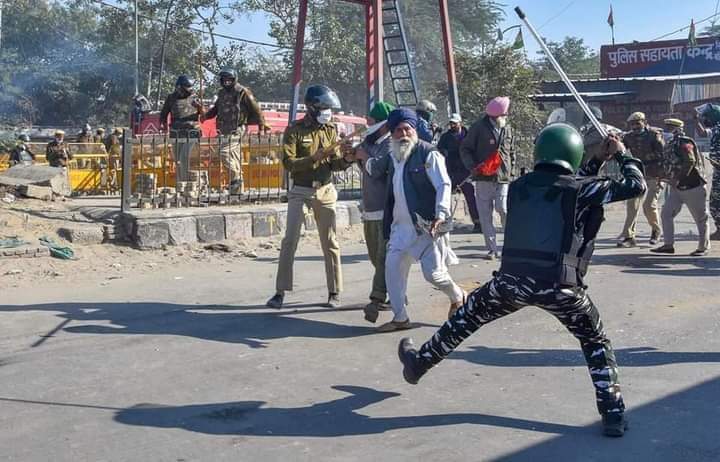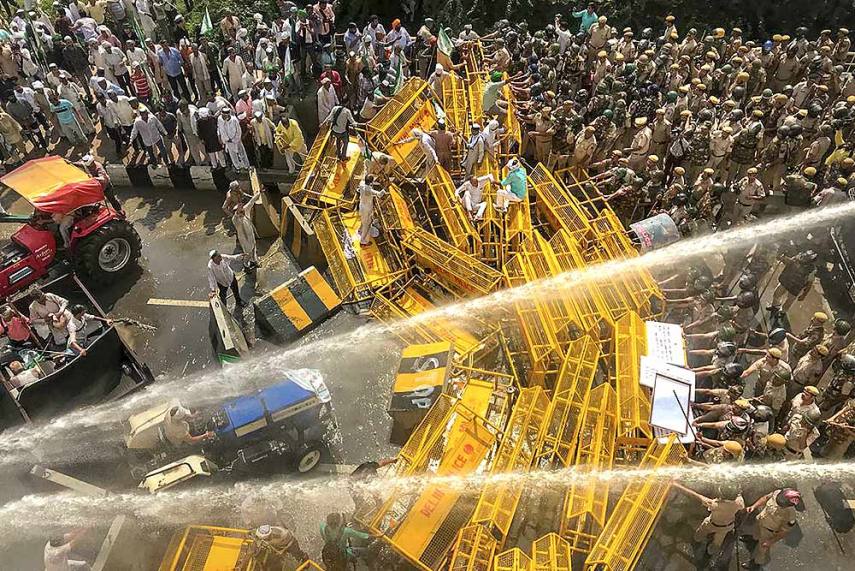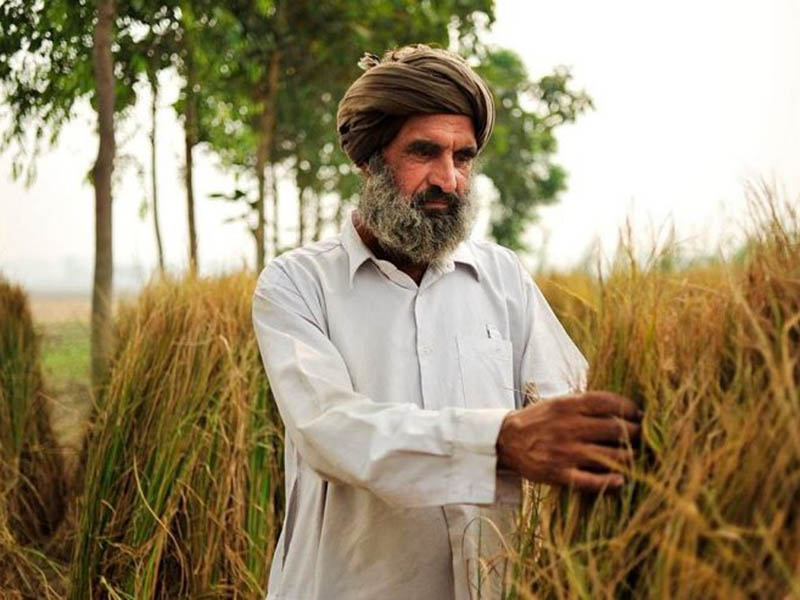By Rajdeep Sardesai. First published in RajdeepSardesai.net on Dec 4th 2020
Are these really farmers who are blocking the roads and protesting?” It’s a quizzical question asked often enough on prime time news tv by many who have rarely stepped out of the air conditioned studio. They are Congress sponsored groups claim government spokespersons; they are Khalistani sympathisers who want to undermine the Indian state suggest the BJP’s hyper-active social media warriors. The first theory can be easily countered: if the Congress really had the resources and organizational might to ‘sponsor’ a farmers movement for even a week, then the party wouldn’t be reduced to just 52 MPs in parliament.
To demonise the protesting farmers as Khalistanis is more unfortunate: it reveals a toxic mindset that seeks to stereotype any anti-government protest as inherently anti-national. The Punjabi Jat farmer’s attachment to land is a bit like the Gujarati middle class community’s connection to the stock market: bring in a stock-market reform that sparks off fears, real or imaginary, over future profits and watch the reaction in an Ahmedabad, Rajkot or Surat. A handful of people who may speak in support of a Bhindranwale’s bloodied legacy can hardly be reason enough to damn a movement of dozens of small and large farmer unions as being driven by Sikh separatism.
Which brings us back to the original question: just who are these protestors who are braving the falling winter temperatures and gheraoing the national capital? What if one suggested that the agitationists are faceless, ordinary Indian citizens who are angry and worried about a new legal framework that could disrupt their traditional working system? It isn’t as if the farmers are impoverished: the average land-holding in Punjab for each farmer is 3.7 hectares, well above the national average. It isn’t as if the new farm laws will destroy their lives: on the contrary, many of the laws could benefit farmers in the long run by eliminating the middlemen. Its just that there has been such a unilateral edge to the Centre’s sudden decision to bring in laws that could potentially change the well-entrenched system of rice and wheat crop sale and purchase that the Punjab farmer is justifiably riven by uncertainty.

The manner in which the farm laws were pushed through a brute majority in parliament without any standing committee oversight and with minimal consultation with stakeholders lies at the root of the present confrontation. When even the Centre’s long-standing ally, the Akali Dal, was forced to withdraw from the government, there was little attempt made to try and reach out to those aggrieved. Politicians may have their own vested interests when breaking up relationships but what of the average farmer groups in distant mandis which have no access to the power elite?
Truth is, a government that rules by diktat is fundamentally mistrusted by affected citizens. The Modi model of governance and reform is built around a ‘strongman’ state which rules by firman with no discussion or dialogue with the affected parties. Then, be it hugely disruptive move like demonetization or a grandiose dream like the central vista project, there is little space for any pre-decision conversation. Recall also the revocation of Article 370 in Jammu and Kashmir, or indeed, the passage of the Citizenship Amendment Act last year. In each instance, dissenting voices were stifled, even criminalized.

For example, the protesting women of Shaheen Bagh were dubbed as ‘Pakistani agents’: it is easy in the present climate of majoritarian ascendancy to target minority groups as ‘anti-national’. Far from reaching out to the women, union ministers even threatened and intimidated them with ‘desh ke gaddaron ko goli maaro’ strident rhetoric. Little attempt was made to strike a meaningful dialogue with the protestors: they were, after all, not seen as a BJP vote bank in any case.
By contrast, the farmers are a crucial vote bank for any government. Prime minister Modi makes it a point to reach out to the ‘gareeb-kisan’ as his core constituency in almost every speech. The government’s media machine repeatedly points out how the Modi government has hiked the minimum support price and provided small and marginal farmers Rs 6000 annual income support under the Pradhan mantri kisan samman nidhi. There is also little doubt that a large number of farmers have voted for the BJP in recent elections: you don’t win two successive majorities in national elections without solid farmer support (Punjab is perhaps an exception here since it is the one state that has resisted the Modi wave in state and national elections since 2014).
It is perhaps a recognition that any kind of farmer ‘revolt’ can quickly spiral out of control that has forced the government to the dialogue table. No dialogue was considered necessary with the affected groups when article 370 was repealed in Jammu and Kashmir or when the CAA legislation was drafted because those who were disturbed by it were not seen to influence the government’s political calculus or threaten the Centre’s supremacy. The kisan is different: a protest which begins in Punjab can easily spread to BJP-ruled neighbouring Haryana, and indeed to other states with large and restive farm populations. Political leaders in the Kashmir valley can be jailed, student activists from a Jawaharlal Nehru University can be browbeaten, the Shaheen Bagh women can be ignored. But an angry and restless farmer must be assuaged.
Which is why the events of the last fortnight perhaps provide a clue to where the ‘real’ opposition to the Modi government’s dominance lies. It doesn’t lie in the political opposition which is weak and directionless, where the leaders of the main national opposition party struggle to go beyond collegiate-style twitter debates. It doesn’t lie in democratic institutions that have been emasculated over time. It doesn’t lie in a mostly pliant media which has, with few exceptions, lost the capacity to tell truth to power. It doesn’t lie in the urban middle class which is way too hypnotized by political Hindutva and the razzmatazz ‘spectacle’ of laser shows by the ghats of Varanasi to even contemplate questioning the larger than life leadership on chaotic blunders like demonetisation.

The ‘opposition’ to domineering governments that rule by decree lies in sizeable groups of ‘ordinary’ Indians, the so-called aam aadmi and aurat, who do not like being taken for granted by their law-makers. Mr Modi still remains the most popular leader in the country by some distance but personal popularity does not guarantee permanent support on each and every issue. A more consensual approach is sometimes needed to remove anxieties and misapprehensions when initiating far-reaching reform: a one-sided diktat is no answer when people need to be first comforted and convinced into acceptance of a new law. Today, it is the farmer who is feeling fearful and angst-ridden, who knows who else will feel aggrieved tomorrow?
Post-script: While the Delhi-centric ‘national’ media’s attention has been focused on the farmers agitation, how many are aware that citizen groups and environmentalists in south Goa have been holding day and night protests against infrastructure projects that threaten the state’s fragile and invaluable forests and wildlife sanctuaries? In a land of a million mutinies, citizen power is the best antidote to executive overreach.
Disclaimer: The opinions expressed within this article are the personal opinions of the author.
Rajdeep Sardesai is an Indian news anchor, journalist and author. He is a consulting editor at the India Today group, and is an anchor for India Today Television. He was the Editor-in-Chief of Global Broadcast News, that included CNN-IBN, IBN7 and IBN-Lokmat, before resigning in July 2014. Tweets with @sardesairajdeep


